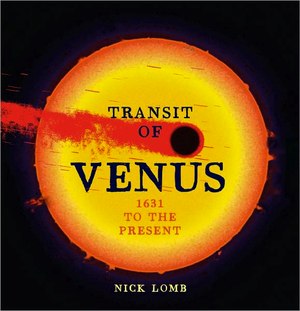Review: Transit of Venusby Jeff Foust
|
| What is today an astronomical curiosity was in previous centuries a key tool for astronomers. |
Today, transits of Venus are primarily an astronomical spectacle, prized for a rarity that makes total solar eclipses look commonplace in comparison. Transits take place in pairs eight years apart; these pairs, though, repeat on cycles of over 100 years. No one alive to witness the 2004 transit had been around for the previous transit, in 1882. Similarly, many argue that this week’s transit will be the last opportunity in anyone’s lifetime to witness such an event, although one can imagine advances in medical science allowing a child who observes this week’s transit to see the 2117 transit as a supercentenarian.
As Nick Lomb explains in his book Transit of Venus, what is today an astronomical curiosity was in previous centuries a key tool for astronomers. Johannes Kepler discovered in the early 17th century that Venus could transit the Sun, predicting a 1631 transit that was not observed. Kepler failed to notice, though, that the transits occurred in pairs, something found by English astronomer Jeremiah Horrocks just a month before the 1639 transit, which he was able to observe. Later, Edmond Halley described how transit observations from different parts of the world could be used to better measure the distance from the Earth to the Sun, or astronomical unit, a poorly-known value that established the scale of the Solar System.
That quest to measure the astronomical unit triggered a series of efforts to observe the transits of 1761 and 1769, and then again in 1874 and 1882. Lomb describes the effort to observe the 1761 transit the “first global scientific event”, with astronomers dispatched from England and France to locales as distant as Cape Town and Siberia. Among those observing the 1761 transit were Charles Mason and Jeremiah Dixon, who a few years later would work together again on a more terrestrial pursuit: mapping the boundary of Maryland and Pennsylvania, and thus establishing what became known as the Mason-Dixon Line.
The 1769 transit also sent astronomers spanning the globe, including an expedition led by Captain James Cook that witnessed the transit from Tahiti. Such expeditions were fraught with danger and death: French astronomer Abbé Jean-Baptiste Chappe d’Auteroche struggled to journey overland across Europe to Siberia to witness the 1761 transit; he saw the 1769 transit from Baja California but succumbed to a fatal disease a few weeks later. The 19th century transits spurred even more expeditions, including several mounted by a new, rising world power: the United States.
| Astronomers will again turn both terrestrial and space-based telescopes towards the transit of Venus this week, although now their interest will be less on the study of this solar system than others. |
Lomb does a fine job describing the history of these transit expeditions in this book, which is filled with illustrations and photographs of these various efforts, up through the 2004 transit. While the original scientific purpose of these transit observations—measuring the value of the astronomical unit—has long been superseded by other techniques, transit observations today still have some scientific interest. The 2004 observations helped astronomers understand the phenomenon known as the “black drop”: the fuzziness visible during the internal contacts just as the full disk of Venus crossed onto the Sun and just as it started to exit. That fuzziness stymied astronomers in earlier transits who were trying to get exact timings of those events; astronomers now believe it’s caused by a combination of the darkening of the Sun’s limb as well as the spreading of light by both the atmosphere and telescope optics.
Astronomers will again turn both terrestrial and space-based telescopes towards the transit of Venus this week, although now their interest will be less on the study of this solar system than others. Transit observations have become a key method for detecting extrasolar planets, or exoplanets, around other stars, a technique used in particular by NASA’s Kepler and France’s CoRoT spacecraft. Observations of a transit of a well-known star by a well-known planet will help astronomers refine their techniques for discovering and studying exoplanets.
Those who do travel to witness this week’s transit will probably do nothing more hazardous than drive to and from the airport, a far cry from those centuries ago who risked, and sometimes lost, their lives in the name of science. Transit of Venus explains both the science of transits and the stories of those willing to risk their lives to observe them.
